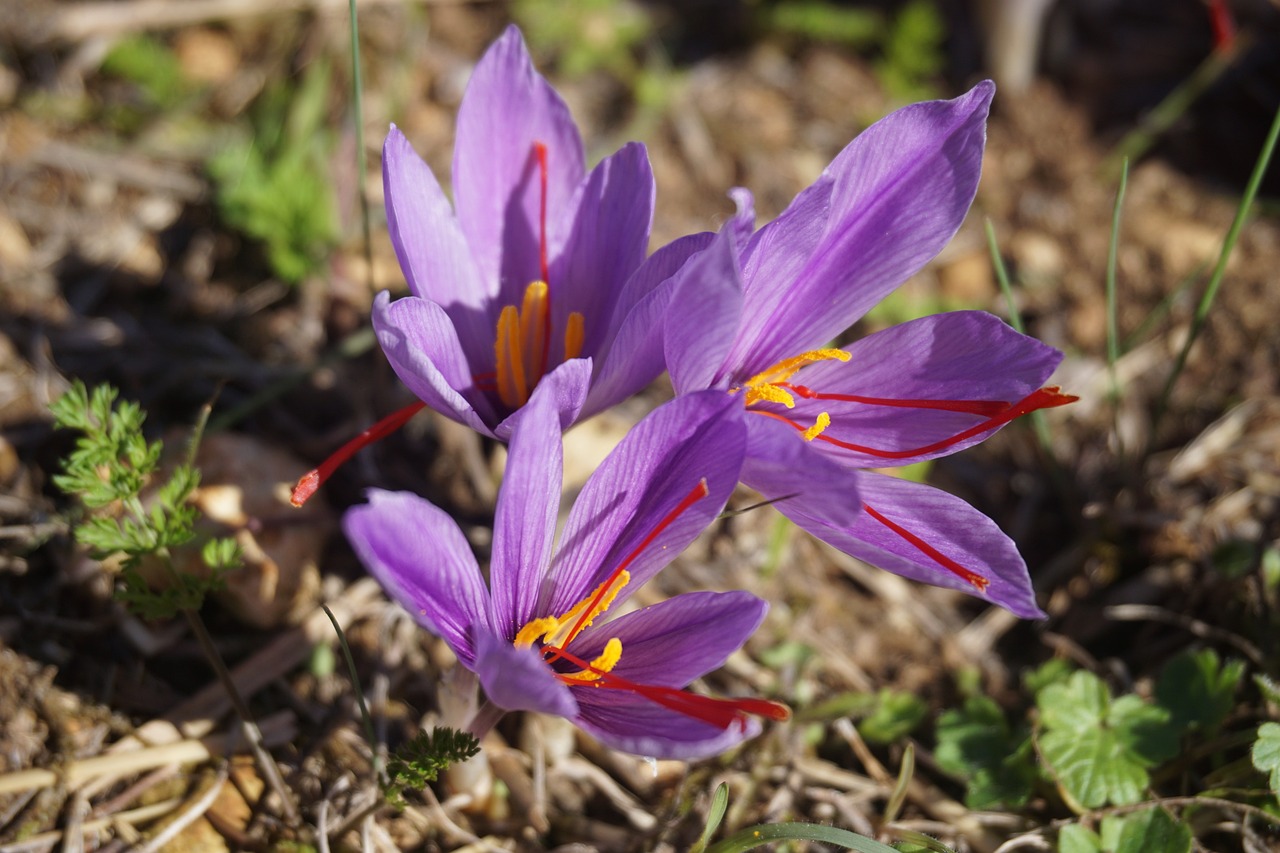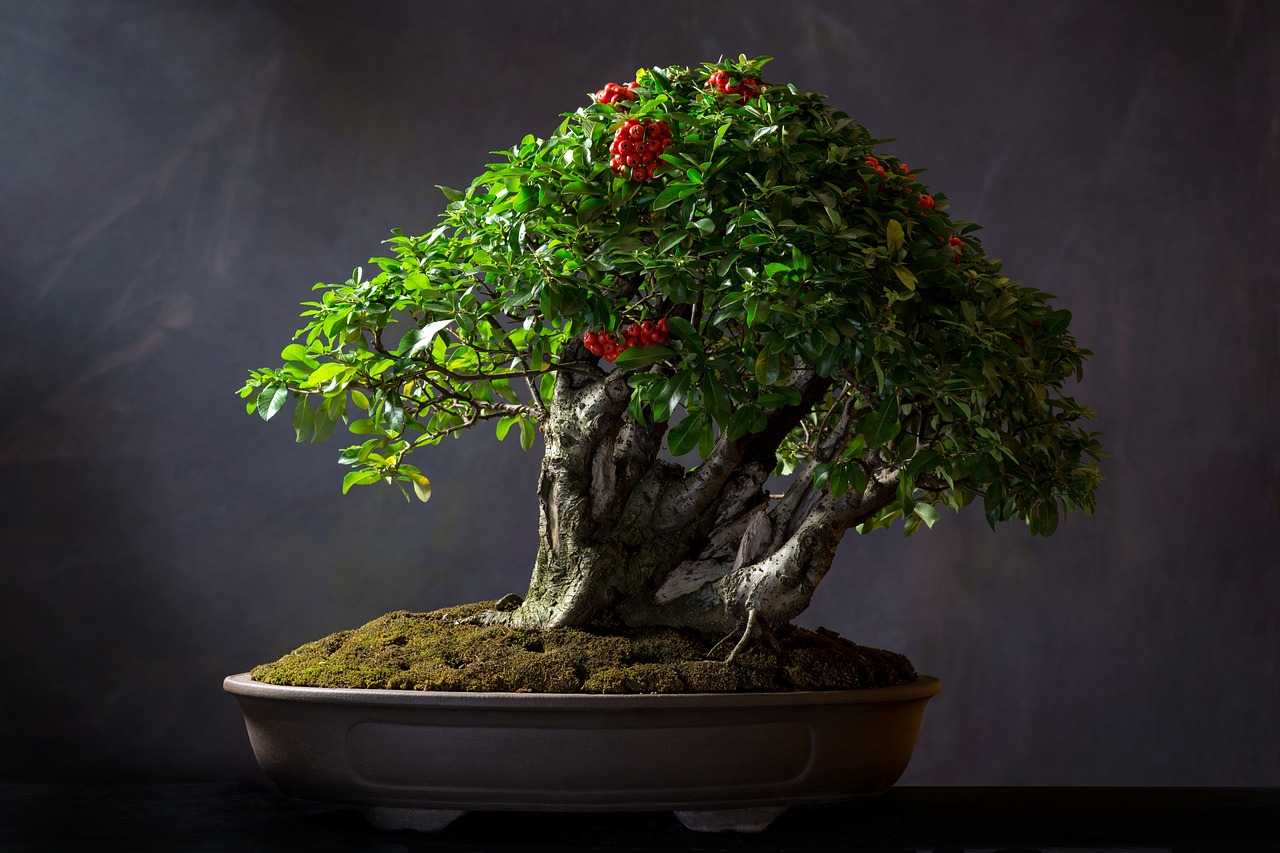Watermelons are a favorite fruit for many, but not all of them come in the typical round shape. In Japan, farmers have been growing square watermelons for decades, turning a simple fruit into a work of art. These perfectly cube-shaped watermelons have captured global attention, not only for their unique appearance but also for their surprising price tags.
What makes square watermelons so special? How are they grown into such precise shapes, and are they really worth their cost? This article takes a deep dive into the fascinating process of creating square watermelons and explores the reasons behind their value.
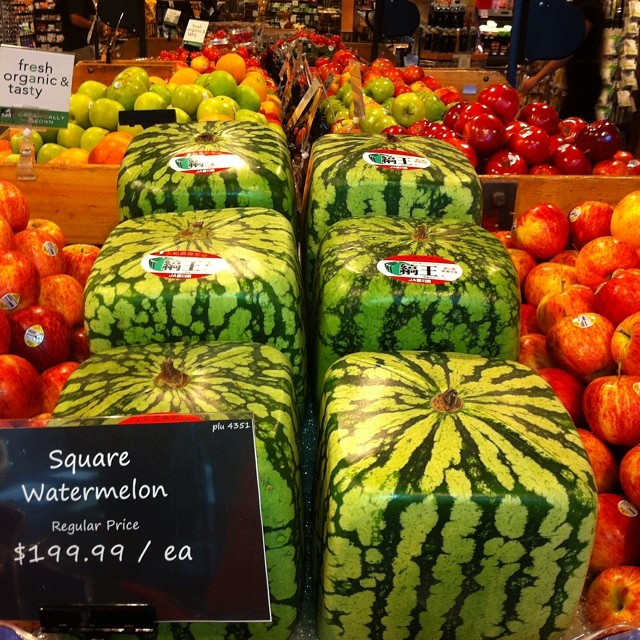 Pin
Pin Image by @dallasfoodforthought
Table of Contents
The Origin of Square Watermelons
Square watermelons were first grown in Japan in the early 1970s. Japanese farmers, always at the forefront of innovation, set out to solve a practical issue: traditional round watermelons are hard to store, stack, and transport. Their uneven shape makes them roll around, wasting space in refrigerators and creating logistical challenges for sellers.
By shaping watermelons into cubes, farmers found a solution that offered both functionality and aesthetic appeal. A square watermelon can fit neatly into small refrigerators, making it especially popular in Japan, where space is limited.
Who Created the First Square Watermelon?
The idea was first introduced by a farmer from Zentsuji City in Kagawa Prefecture, Japan. The region became the birthplace of square watermelons, and to this day, it remains one of the key producers of these unique fruits.
How Are Square Watermelons Grown?
 Pin
Pin Image by @onlyinjapantv
Growing square watermelons is a delicate process that requires precision, patience, and expertise. Here’s a step-by-step look at how farmers achieve this impressive feat:
- Step 1 – Choosing the Right Watermelon: The process begins with selecting a suitable variety of watermelon. Farmers usually choose smaller, slower-growing varieties because they are easier to mold into specific shapes.
- Step 2 – Using Transparent Boxes: Once the watermelon plant starts producing small fruits, the young watermelons are placed inside transparent, cube-shaped boxes. These boxes are usually made of durable materials like acrylic or glass to withstand the pressure of the growing fruit. The clear boxes allow sunlight to reach the watermelon, which is essential for growth and ripening.
- Step 3 – Monitoring Growth Carefully: As the watermelon grows, it gradually conforms to the shape of the box. Farmers monitor the growth daily, ensuring the fruit fills the cube evenly without cracking or becoming misshapen. This requires meticulous care, as even minor mistakes can ruin the shape or quality of the watermelon.
- Step 4 – Harvesting at the Right Time: Once the watermelon has fully grown and taken on the desired square shape, it is carefully removed from the box and harvested. The timing is critical—harvesting too early or too late can affect the watermelon’s appearance and taste.
Why Are Square Watermelons Grown?
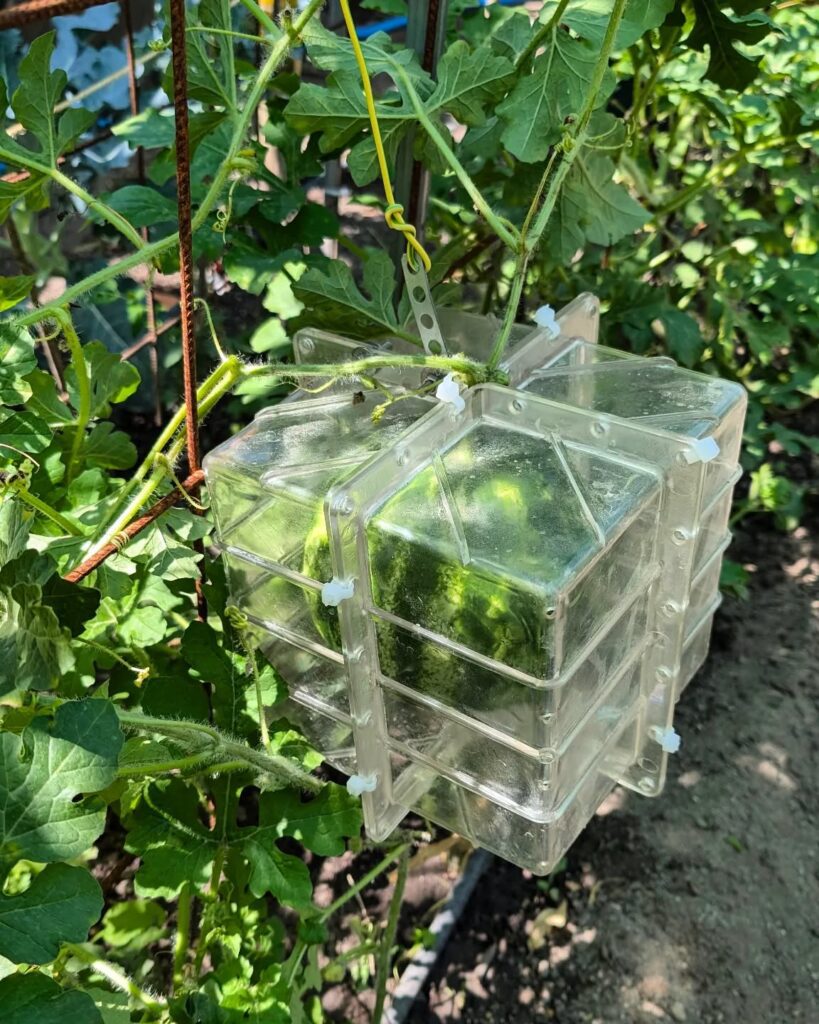 Pin
Pin Image by @saturno.4409
At first glance, square watermelons might seem like nothing more than a modern gimmick—a quirky idea designed purely to capture attention. However, these carefully shaped fruits serve a purpose that extends beyond their unique aesthetics. Square watermelons are a product of innovation, practicality, and cultural significance. Let’s explore the reasons behind their creation in more detail.
Practical Storage and Transport
One of the main reasons square watermelons were developed was to address a practical challenge: the awkward shape of traditional watermelons. Round watermelons, while natural, present logistical problems for storage and transportation.
In Japan—where the concept of square watermelons originated—space is a luxury. Japanese homes are often compact, and their refrigerators are smaller compared to those in Western countries. Traditional round watermelons take up irregular space, roll around, and can be hard to fit neatly into tight refrigerator compartments.
By reshaping watermelons into cubes, farmers provided a practical solution. A square watermelon:
- Fits neatly on shelves without rolling.
- Stacks efficiently, saving valuable space during storage and transport.
- Maximizes refrigerator space, making it ideal for small kitchens.
This cubic design is also a boon for retailers. Square watermelons can be lined up and stacked like boxes, making displays visually appealing and space-efficient. For transportation, they take up less room and reduce the risk of rolling and bruising, which is common with round watermelons.
What began as a creative solution to a storage problem has now become an elegant combination of form and function, earning square watermelons a unique place in agricultural innovation.
Symbol of Art and Luxury
While square watermelons solve practical challenges, they are also celebrated as a symbol of craftsmanship and luxury—especially in Japan.
In Japanese culture, fruits are not viewed merely as everyday food but as objects of beauty, care, and perfection. High-quality fruits are often given as prestigious gifts during special occasions, such as weddings, business meetings, or holidays. For these events, the appearance of the fruit matters just as much as its taste.
Square watermelons embody the meticulous care and creativity that Japanese farmers put into their work. Growing a perfect square watermelon requires skill, precision, and patience. Each fruit is closely monitored to ensure it develops into a flawless cube, making it a true agricultural work of art.
When presented as a gift, a square watermelon is not just a fruit; it’s a statement of luxury and thoughtfulness. Its unusual appearance symbolizes rarity and exclusivity, which adds to its value. For many buyers, the price tag reflects not just the watermelon itself but the artistry, effort, and tradition behind it.
In Japan, these perfectly shaped fruits are often displayed as centerpieces in homes, high-end stores, or luxury events. People appreciate them for their aesthetic value, much like they would a beautiful painting or sculpture.
Curiosity and Novelty
Square watermelons have also captured the world’s imagination because of their sheer novelty. In a world where consumers are always looking for the next big thing, these watermelons provide a unique conversation starter.
Their unusual shape makes them highly marketable and instantly shareable. Social media platforms, news outlets, and influencers often feature square watermelons as an example of creativity and innovation in agriculture. Seeing a watermelon that defies expectations naturally sparks curiosity and excitement.
Blending Form, Function, and Culture
The existence of square watermelons perfectly blends form, function, and cultural values. What began as a practical innovation has grown into a cultural symbol of artistry and uniqueness. These fruits represent more than just food; they are an intersection of:
- Utility, offering practical benefits for storage and transport.
- Luxury, serving as gifts and decorative items.
- Innovation, showcasing the ingenuity of farmers who transform nature into art.
For many people, square watermelons are not about taste or convenience but about the story they tell—a story of creativity, precision, and a touch of whimsy. They remind us that even something as ordinary as a watermelon can be elevated into something extraordinary.
Are Square Watermelons Edible?
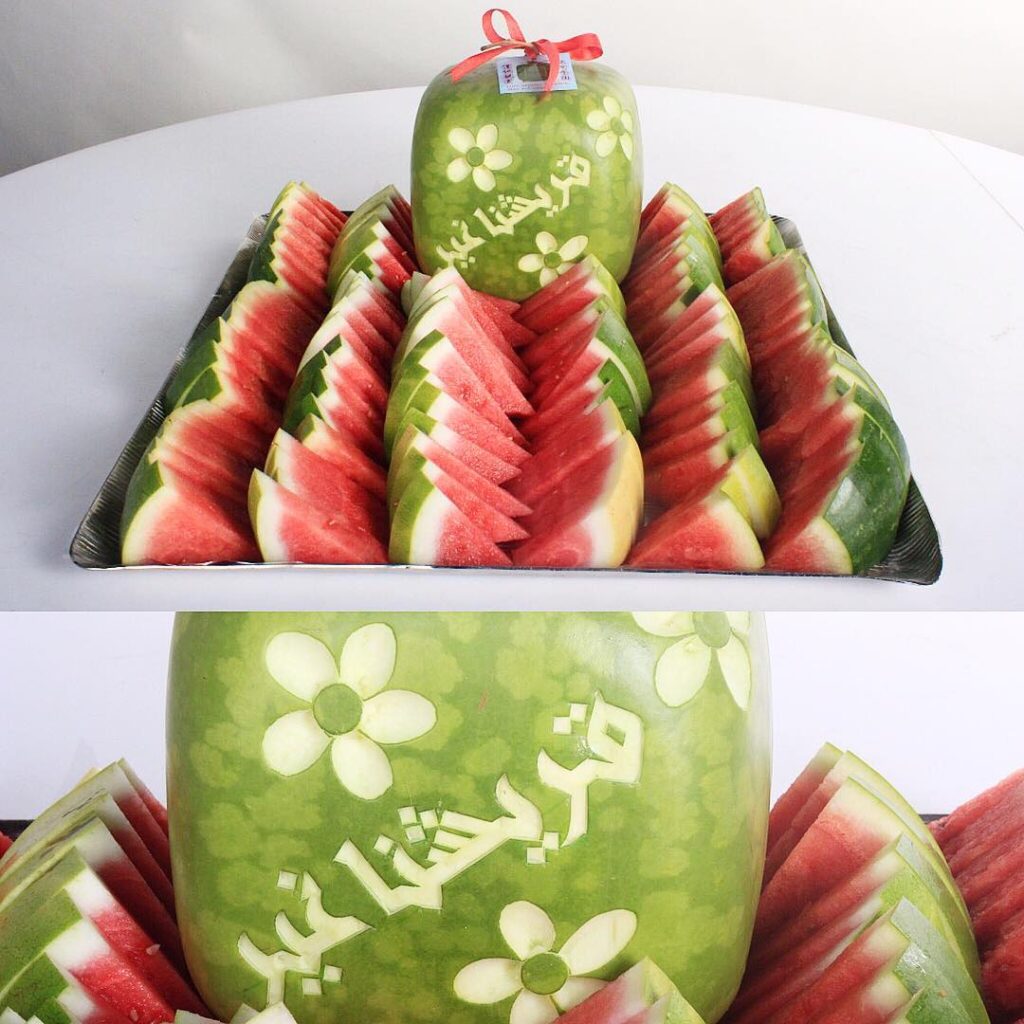 Pin
Pin Image by @fresh_couture
One of the most common questions about square watermelons is whether they are edible. The answer is yes, but there’s a catch.
Most square watermelons are harvested before they fully ripen to ensure they maintain their perfect cube shape. As a result, they tend to be less sweet and not as juicy as regular watermelons. For this reason, square watermelons are primarily used for decorative purposes rather than eating.
If you’re looking for taste, traditional round watermelons remain the better option.
How Much Do Square Watermelons Cost?
 Pin
Pin Image by @jamieinthemorn
Square watermelons are far from your average fruit purchase. Their price can surprise even the most seasoned shoppers, as they often cost significantly more than traditional watermelons. Depending on the quality, size, and location, a square watermelon can range anywhere from $80 to $200—and in some cases, even more.
The Premium Price Tag
In Japan, where square watermelons originated, these unique fruits are often sold in luxury fruit markets and upscale department stores. Unlike regular watermelons found in grocery stores, square watermelons are presented as premium items, carefully packaged and displayed like works of art.
For those seeking the very best, some rare or perfectly shaped square watermelons have fetched prices exceeding $500! These high-end fruits are prized for their flawless symmetry and craftsmanship, qualities that make them worthy of luxury status.
Why Are They So Expensive?
1. Labor-Intensive Process
Growing a square watermelon is no easy task. It’s a process that demands meticulous care, time, and expertise. Farmers must place each young watermelon into a perfectly shaped mold and monitor its growth daily.
If the fruit grows too quickly, it may crack.
If it’s neglected, it may not fill the mold properly, resulting in imperfections.
Ensuring that the watermelon develops into a precise cube requires a hands-on approach, making it far more labor-intensive than growing regular round watermelons. This painstaking attention to detail drives up the cost significantly.
2. Low Supply, High Demand
Square watermelons are produced in limited quantities, adding to their rarity. Since the process requires so much effort and precision, only a small number of these unique fruits are grown each year. This limited supply naturally creates a high demand among collectors, luxury buyers, and those looking for exclusive gifts.
In markets like Japan, where rare and beautifully crafted items are highly valued, the exclusivity of square watermelons further justifies their premium price.
3. Cultural Value
In Japan, fruit holds a special place in cultural traditions. High-quality fruits, including melons, are often exchanged as luxury gifts during special occasions like weddings, holidays, and business transactions. A beautifully grown square watermelon represents thoughtfulness, care, and prestige, making it the perfect gift for someone important.
The craftsmanship behind growing square watermelons also adds to their appeal. These fruits are not just produce—they are seen as agricultural art, showcasing the farmer’s dedication and skill. Buyers pay a premium not just for the fruit itself but for the story and effort behind its creation.
Are There Other Shaped Watermelons?
Square watermelons may be the most famous, but they are not the only uniquely shaped watermelons on the market. Farmers have taken the concept of molding fruit even further, creating watermelons in a variety of shapes that are equally impressive and eye-catching.
Heart-Shaped Watermelons
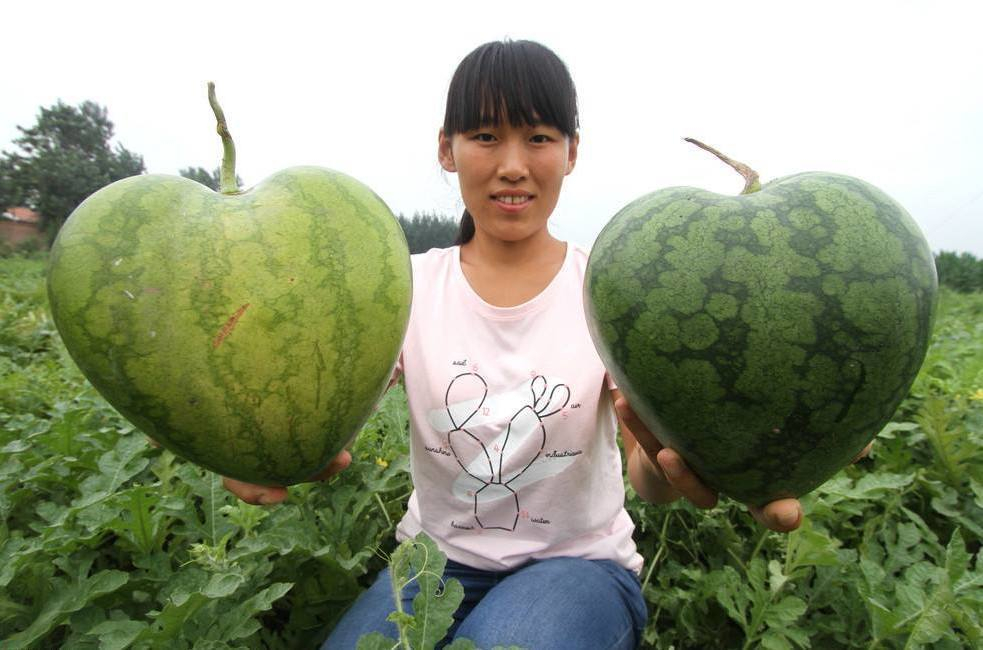 Pin
Pin Image by @jamieinthemorn
Heart-shaped watermelons are a romantic twist on this agricultural trend. These watermelons are grown using specially designed heart-shaped molds that guide the fruit as it matures. They are particularly popular during Valentine’s Day or anniversaries, making them a perfect gift for loved ones.
Heart-shaped watermelons symbolize love and care, and their unique form makes them an ideal choice for special occasions. Like square watermelons, they require careful monitoring and precision to achieve the perfect shape.
Pyramid-Shaped Watermelons
 Pin
Pin Image by @ohayo_dk
Pyramid-shaped watermelons are another rare and fascinating variation. These watermelons take on a triangular form, resembling miniature pyramids. Growing pyramid-shaped watermelons is even more challenging than square ones, as the fruit must develop sharp edges and maintain symmetry within the mold.
Because of the additional complexity involved, pyramid-shaped watermelons are rarely produced and are considered highly exclusive novelty items. They often appear in luxury markets or exhibitions, where they draw attention for their unique and artistic design.
How Are These Shapes Achieved?
The process of creating heart-shaped and pyramid-shaped watermelons follows a similar approach to square watermelons:
- Selecting the Right Mold: Farmers use custom-designed molds made of durable materials like glass, acrylic, or plastic. These molds guide the watermelon’s growth while protecting it from damage.
- Monitoring Growth: As with square watermelons, the growing process requires constant attention. Any misstep—such as uneven growth or mold imperfections—can affect the final shape.
- Harvesting Carefully: Timing is critical to ensure the watermelon fills the mold completely without overgrowing or cracking.
While the principles remain the same, heart and pyramid-shaped watermelons often require even more precision due to their intricate designs. This added complexity further limits their availability and increases their value.
Can You Grow Square Watermelons at Home?
Yes, growing square watermelons at home is entirely possible for those who enjoy a challenge and have a bit of patience. While professional farmers achieve flawless cubes with years of experience, you can try creating your own unique version with a little care and dedication.
What You’ll Need:
- A Small Watermelon Variety: Choose a variety that grows to a manageable size, such as “Sugar Baby” or other compact watermelons. Smaller watermelons are easier to shape and monitor.
- A Square, Transparent Mold: You can use a clear acrylic, glass, or sturdy plastic box with ventilation holes. The transparency allows sunlight to reach the growing watermelon.
- Proper Growing Conditions: Ensure the watermelon gets ample sunlight, water, and nutrients while it develops inside the mold.
Key to Success
The trick is timing and consistent care. Place the young watermelon in the mold early, when it’s still small, and monitor its progress daily. Ensure it grows evenly within the mold, adjusting positioning if necessary.
While your homemade square watermelon may not achieve professional perfection, the process can be both fun and rewarding. Plus, it’s a fantastic way to impress your friends with a little agricultural creativity!
Conclusion: Are Square Watermelons Worth It?
Square watermelons are more than just a quirky fruit; they represent creativity, precision, and a deep appreciation for agricultural art. While they may not be the sweetest or most practical watermelon to eat, they hold immense value as luxury items, gifts, and conversation starters.
For those who appreciate craftsmanship and novelty, a square watermelon is worth the price. However, if you’re simply craving a refreshing summer treat, a traditional round watermelon will always be the better choice.
Square watermelons remind us that even something as ordinary as a fruit can be transformed into something extraordinary through innovation and imagination.








